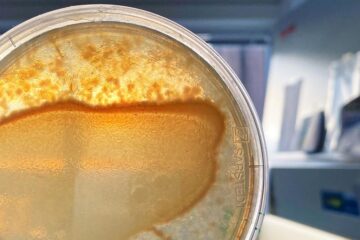HPL Culture System – Two-phase cell culture system based upon human platelet lysate

In order to provide cells with a sufficient amount of growth factors, they are usually cultured in medium supplemented with fetal calve serum (FCS) or other blood sera. In the case of therapeutic applications, these xenogenic components bear the risk of immunologic reactions and infection with viruses or prions. Human platelet lysate (HPL) is considered to be an attractive alternative to FCS. It has been shown that HPL-supplemented cell culture medium yields a high expansion rate and is superior to FCS even during longterm cultivation.
Still, cells covered with HPL-medium do not experience optimal growth conditions, as they are usually cultured on a plastic surface which involves contact inhibition and enzymatic treatment during passaging. Invention :This invention relates to a cell culture system based upon human platelet lysate (HPL) and standard cell culture medium. The two-phase system consists of HPL-medium and HPL-gel. Both components only differ in the addition of a polymerization-inhibiting substance, e.g. heparin (compare Fig.1). In this way, growth factors are provided in a constant concentration throughout the culture system and three-dimensional cell growth is facilitated, thus minimizing contact inhibition. It has been shown that culturing mesenchymal stromal cells (MSC) on HPL-gel yields a higher proliferation rate (compare Fig. 3) and CFU-f outgrowth compared to a plastic surface and collagen-gel. Cell passaging can either be performed enzymatically or by mechanical gel fragmentation with a pipette (compare Fig. 2). Summing up, the novel HPL culture system provides excellent growth conditions for standard cell culture as well as for cell therapeutic applications.
Weitere Informationen: PDF
PROvendis GmbH
Tel.: +49 (0)208/94105 10
Ansprechpartner
Dipl.-Ing. Alfred Schillert
Media Contact
Alle Nachrichten aus der Kategorie: Technologieangebote
Neueste Beiträge

Das Mikrobiom verändert sich dynamisch und begünstigt wichtige Funktionen für den Wirt
Ein interdisziplinäres Forschungsteam des Kieler SFB 1182 untersucht am Beispiel von Fadenwürmern, welche Prozesse die Zusammensetzung des Mikrobioms in Wirtslebewesen steuern. Alle vielzelligen Lebewesen – von den einfachsten tierischen und…

Wasser im Boden – genaue Daten für Landwirtschaft und Klimaforschung
Die PTB präsentiert auf der Woche der Umwelt, wie sich die Bodenfeuchte mithilfe von Neutronenstrahlung messen lässt. Die Bodenfeuchte hat nicht nur Auswirkungen auf die Landwirtschaft, sondern ist als Teil…

Bioreaktor- und Kryotechnologien für bessere Wirkstofftests mit humanen Zellkulturen
Medizinische Wirkstoffforschung… Viele Neuentwicklungen von medizinischen Wirkstoffen scheitern, weil trotz erfolgreicher Labortests mit Zellkulturen starke Nebenwirkungen bei Probanden auftreten. Dies kann passieren, wenn zum Beispiel die verwendeten Zellen aus tierischem…

















